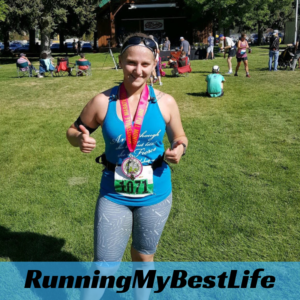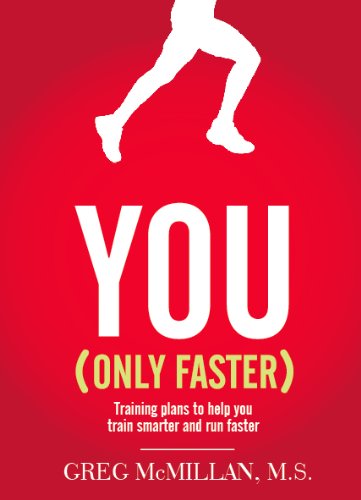Creating a custom training plan to guide your running isn’t as hard as it sounds. You just have to start with the basics and then make small tweaks.
Why not just train with a generic plan as it is?
You could definitely train with a free plan, such as Hal Higdon’s plans. If you’re just starting out, that’s honestly the best option. Just be sure to listen to your body as you go and take a break if you feel like you’re on the verge of injury or burnout.
Customizing your training plan is an advanced technique recommended for runners who are intermediate to advanced, but beginners can also take advantage of the first few steps to help their training plan fit their schedule.
After you complete a few different training plans and get to know how your body responds to key workouts, how long it takes to recover after a hard session, what type of cross training you like to incorporate, and how many days per week you can realistically dedicate to training, you will have a solid idea of the ingredients you need to create your custom training plan.
Most of the information in this article comes from my personal experience customizing my own training plans, but I also pulled several ideas from Greg McMillan’s book, You (Only Faster). I highly recommend grabbing a copy of this book and reading it cover to cover, especially if you are self-coached.

Selecting the Right Training Plan
To get started, you need to find a training plan template. There are many free training plans you can find online to use as a template. One of the most reputable sources for free training plans is Hal Higdon. Remember, this is only your starting point.
I recommend at searching for plans based on your race distance, difficulty/experience level, and how many days per week require training.
Race Distance
Are you training for a 5k, 10k, half marathon, full marathon, or ultramarathon?
Training plans vary greatly in total weekly mileage, and your weekly long run. Start by searching for a plan that serves your primary race distance. If you have multiple races throughout the course of your training, look for a training plan for the longest race distance you have on your calendar.
Select a plan template appropriate for your goal race distance.
[convertkit form=964110]
Difficulty Level
This one is important as well because you can either challenge yourself too much or not enough. It may be tempting to jump into an “advanced” plan, but please be honest with yourself. Trying to do too much too soon is recipe for injury and burnout.
If you’ve never run a marathon before, choose the beginner plan…not the intermediate plan. And definitely don’t choose the advanced option unless you’re already experienced with that race distance and are training for a personal best.
As a policy when designing my own plans, I always err on the side of caution. I’d rather progress slower and avoid injury. If you push too hard and have to take several weeks off to rehab an injury, you’re going to make much slower progress or even go backwards in your fitness.
Consistency beats aggressiveness when it comes to running for the long term.
On the flip side, do be sure to challenge yourself. If you’ve already completed the beginner plan for that distance, bump yourself up to the next plan or intermediate version.
How Many Days Do You Want to Run or Cross-train Per Week?
Too many people overlook this factor when choosing a training plan template and building their custom training plan.
Look at your typical weekly schedule and when you actually have time to work out. If you know there’s that one day in your schedule that involves a long day at the office, early or late meetings, or evening sports for the kids that just won’t give you time to do your training, then plan for that as a rest day.
Also, there might be a day in your week when you think you can workout but it just never really happens on the follow through.
I tried running 6 days per week during one training cycle, and I tended to opt for rest instead of doing an easy run on the last day of the week. In future training plans, I just made that day a yoga or rest day instead. I’m not sure about you, but I get a lot of satisfaction when I complete my plan as written, and I tend to feel disappointed if I don’t complete a prescribed run—even if I know it was best for me to give my body a break. Now, I shoot for running 5 days per week with 1-2 strength workouts.
Adjust the plan to fit your needs
After you find your training plan template, it’s time to adjust your plan and turn it into your custom training plan. Next, grab a copy of my “Running Workout Tracker”. This is not a training plan in itself, it’s actually a spreadsheet designed for you to plug your training plan into and customize your plan based on the ideas discussed in this article. Then you can use it to track your runs by plugging in your mileage below each planned workout, and it adds up your weekly totals.
I’ve been using this spreadsheet for over 2 years and 10+ training plans. It works great and it’s a super convenient way to create your custom training plan! You can enter your email below and I’ll send you the free download.
[convertkit form=878335]
Shift Your Plan to Fit the Days of the Week You Can Do Specific Workouts
Just because a training plan template says to do your long run on Saturday doesn’t mean you have to do it on Saturday! You can do your long run on Friday or Sunday or heck, if you work an irregular schedule, you can even do your long run on Wednesday. Whatever works best for you and your schedule.
I like to line up the long run in my training plan first, because it can require a large time commitment—especially for half marathon and full marathon training plans.
After that, you can plug in your strength workout or track run if there are certain days of the week you have access to those facilities. Is there a weekly yoga class you just can’t go without? Take account for that when you build your custom training plan. I like to put ALL of my workouts in my plan so I can see the full picture of training stress and active recovery when review it.
Learn How Your Body Responds After Certain Workouts
Your body will respond differently to different workouts. For some people, they take more time to recover after long endurance runs. Others (like me!) take longer to adapt and recover after a speed workout.
Leg day is an important staple in my training diet, plus key to maintaining stability and preventing injuries. However, it takes me 2 full days to recover after leg day before my legs feel fresh and ready to do any type of hard workout again. Thus, I plan my workouts accordingly.
Because I double up one strength session with a running session each week to fit all my planned workouts in, I do a track or speed workout before my leg day strength session. This way, I get the benefits of the speed workout and the strength workout while recovering from them at the same time. Then, I plan an easy run the following day with a rest day after that. By the third day, my body is rested up and ready to go again.
Related: 4 Injury Prevention Fundamentals for Runners to Live By

Pay Attention to Adequate Recovery Time
Sometimes when one week ends and another begins, we forget that the days are actually one continuous line as far as our bodies are concerned. I’ve learned the hard way that if I race (hard effort at any distance—even a shorter race like a 5k), then my body needs at least 2 days of rest or easy runs before I can do a hard run again. More recovery days for a half marathon.
For example, my races pretty much always fall on a Saturday, and I tend to do my track workouts on Monday. A couple times early this spring, I started my Monday workout only to realize that my legs still felt like lead after racing on the Saturday before. On these weeks, I’ll do an easy workout on Monday and move my speed session to Tuesday or Wednesday, so my body has more time to recover between hard efforts.
This applies to hard workouts such as speed runs or long runs in your week as well. Obey the stress/rest cycle. Do at least 1-2 easy days between each hard run or workout. You may find that this limits how many speed workouts you can do in a week. That’s the point. Most of your training should be at a slow, easy pace. In fact, 80% of your weekly miles should be run at a ridiculously easy pace.
Related: 80/20 Running: Why You Need to Slow Down
Add (or Subtract) Weeks to Make the Plan Fit Your Goal Race Date
You want to line up your custom training plan weeks so you peak and taper in time for your goal race. If the training plan template you select is 12 weeks and you have more or less than exactly 12 weeks before your goal race, you may need to add (or subtract) training weeks to make the plan fit.
Adding weeks is almost always better than subtracting weeks, especially when you are building mileage and running farther than you have before. It’s better to have more time to allow your body to adapt and recover than it is to try and push your body too far too fast.
If you have more than 12 weeks before your race, add base training at beginning of your training plan to help your body to prepare for the stress of race training. If you are concerned with rapidly increasing mileage or how your body might respond to an especially hard week, another option is to add a recovery after an especially long or hard training week.
A recovery week is a 25-40% reduction in your weekly miles, with all of your runs being an easy effort. I’ve found the recovery week especially helpful in injury prevention when building up to a new race distance.
Related: What is Base Training and How to Build It
Learn More About Creating Your Custom Training Plan
If this topic interests you and you want to learn more tips, tricks, and guidelines for customizing your workout plan and creating a custom training schedule, I highly recommend grabbing a copy of Greg McMillan’s book, You (Only Faster).
This book will walk you through step-by-step to select a training plan, determine which type of runner you are, how to train properly using different training zones, the finer points of designing a custom training plan, and the 10 Rules of Running.
Have you ever customized your training plan, or do you follow the exact template of a premade plan?

Run Happy,
Alexis
- Nailing Your Marathon Hydration Strategy: A Comprehensive Guide
- Conquering Marathons in the Cold: A Comprehensive Guide
- Harnessing the Power of Technology for Successful Marathon Training
- Mastering the Marathon: The Ultimate Guide to Nutrition and Training
- Ultimate Guide to the Top 5 Running Shoes for Beginners in 2023
About Me: I’m Alexis, Founder of RunningMyBestLife! I am an avid recreational runner, half marathoner, wife, dog mom, busy professional, downhill skier in Northern Utah. My mission is to help new enthusiasts fall in love with the sport of running. I believe that running is a catalyst to taking control of your life and living your best life by design. Learn More –>
